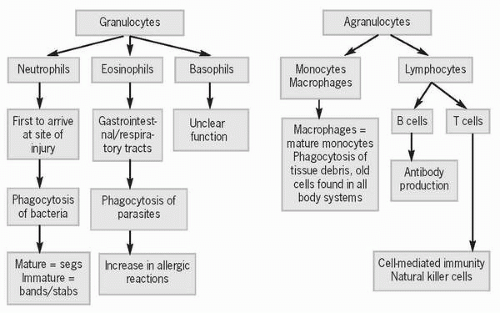Leukocytes
Leukocytes, or white blood cells (WBCs), have specific functions involving the inflammatory process, namely, to defend the body against infection and to clean up the byproducts of inflammation and infection. They travel via the circulatory system to the site of inflammation or infection by responding to chemical signals released by damaged cells. The total leukocyte count in a healthy adult is between 5,000 and 10,000/mm3 of blood. Leukocytes are divided into phagocytic granulocytes (i.e., neutrophils, eosinophils, and basophils) and agranulocytes (i.e., phagocytic monocytes, phagocytic macrophages, and immunocytic lymphocytes). Colony-stimulating factors produced by endothelial cells, fibroblasts, and lymphocytes are responsible for the production, maturation, and function of leukocytes.
All leukocytes come from stem cells in the bone marrow. Granulocytes are released from the bone marrow as mature cells, whereas agranulocytes are released as immature cells. Leukocyte production is increased in response to biological triggers, such as infection, strenuous exercise, fever, stress, and tachycardia, and psychological triggers, such as pain and anxiety.
TERMS
 Figure 7-1 Leukocytes. |
Granulocytes are leukocytes that contain cytoplasmic granules, which contain enzymes and multilobar nuclei. The enzymes in granulocytes have several functions, including killing invading microorganisms, cleaning up the resulting debris, and releasing chemical mediators involved in the inflammatory process. The three types of granulocytes are neutrophils, eosinophils, and basophils.
Stay updated, free articles. Join our Telegram channel

Full access? Get Clinical Tree


